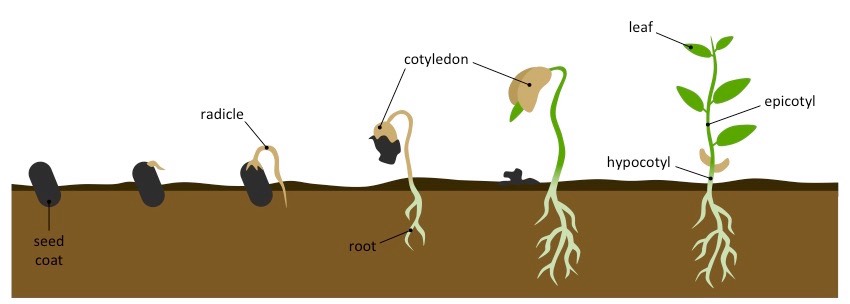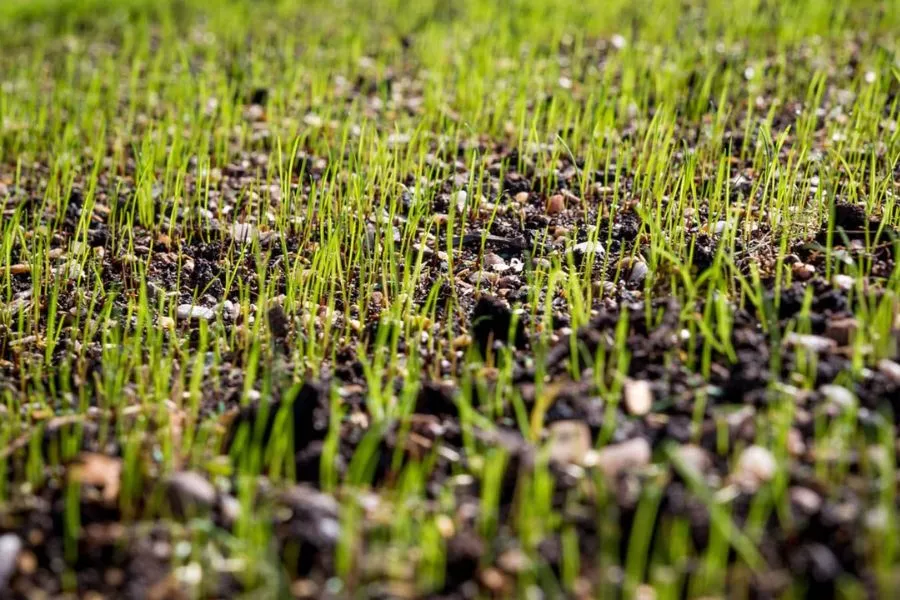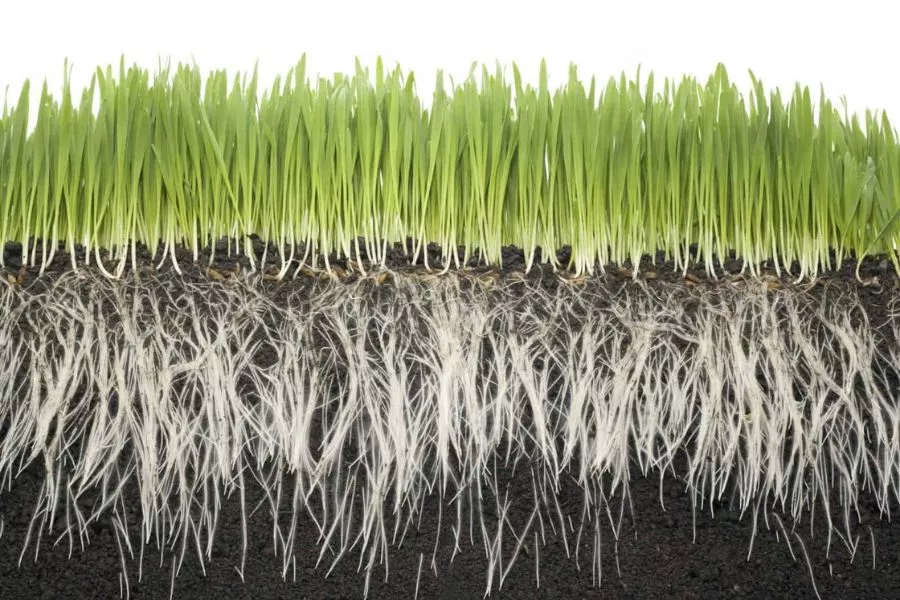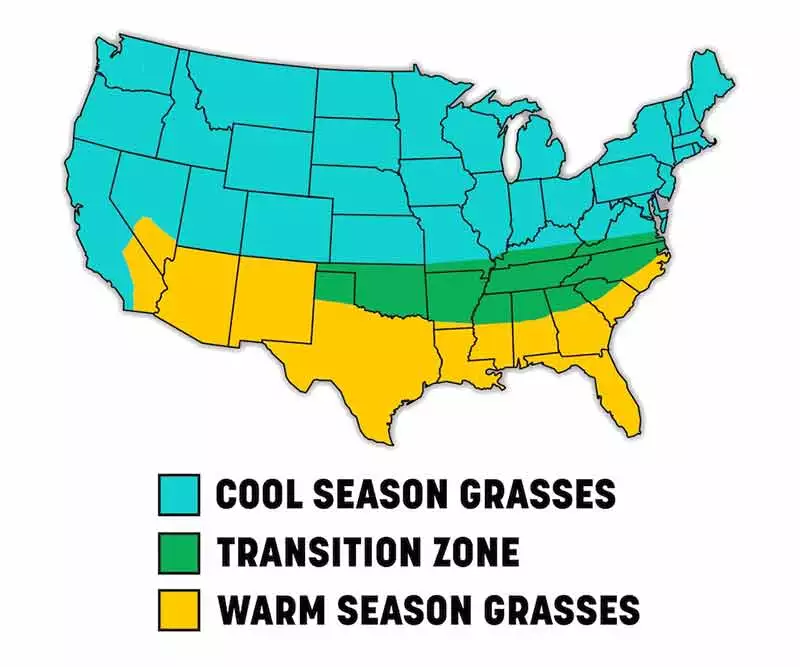If you’re looking for how to make grass seed grow faster, you’ve come to the right place. Grass seed is a crucial part of any healthy lawn, but sometimes it can take a while for that grass to start growing. In this blog post, we’ll share tips on making your grass seed grow as quickly as possible. Keep reading for more information!
What is seed germination?
According to Britannica, Germination is the sprouting of a seed, spore, or other reproductive body after dormancy. The process by which seeds start to develop into plants, including their roots, branches, and leaves, is known as germination. Simple you can say, seed germination is how plants grow from a single seed.

When the process of germination is over, the seedling begins to grow, which signifies a shift in priorities to the rapid growth of root and shoot as well as the establishment of a photosynthetic seedling. Seedling growth is the stage in a green plant’s life cycle from radicle emergence through seed coat to enough green leaves to be self-sufficient.
How to make grass seed grow faster in 9 easy steps
A healthy lawn is the foundation of a beautiful garden. Grass is an essential element of any lawn, and seeding a new lawn is a great way to add fresh, green grass to your yard. Let’s know some tips on making your grass seed grow faster.
Soaking grass seed speed up germination
Though you may be eager to see your new grass seedlings poking through the soil, it’s important to resist the temptation to water too frequently. Overwatering can actually delay germination by causing the seed to rot. Instead, it’s best to soak the seeds overnight before planting. This will help to hydrate the seed and encourage faster germination.
Simply add the seed to a container of water and allow it to soak for at least eight hours. Drain any excess water before planting, and then water lightly every day until the seedlings appear. With this simple soaking step, you’ll be on your way to a lush, green lawn in no time.

Frequent, light watering speeds grass seed growth.
While there are many factors that contribute to fast grass growth, one of the most important is watering. Water is essential for all plant life, and it plays a particularly important role in seed germination. New seedlings are delicate, and they require a consistent supply of moisture in order to thrive. That said, it’s important to water frequently and lightly rather than deeply and infrequently.
Deep watering can encourage shallow root growth, while light watering will encourage deeper roots. Deep roots are better able to withstand drought conditions, so light and frequent watering is the best way to promote fast grass growth.
In addition, be sure to water in the morning so that the sun can help evaporate any excess water on the leaves of the grass plants. By following these simple tips, you can ensure that your new grass seedlings get off to a strong start.
Coat or buy coated seed for faster germination
Any gardener knows that grass seed is essential for a healthy lawn. However, grass seeds can be slow to germinate, particularly in areas with low moisture levels. One way to help speed up the germination process is to add a coating or purchase coated seed.
A coating can help to retain moisture and protect the seed from pests and diseases. Moreover, it can provide essential nutrients that promote growth. Some commercially available coatings even contain nitrogen, which can help to stimulate root growth. While coated seed may be more expensive than uncoated seed, the extra cost may be worth it for gardeners who are looking for a fast-growing lawn.
Loosening and dampening the soil
The loosening of the top two inches of the soil allows for better aeration. Aeration is important for the uptake of water and nutrients by the grassroots. It also allows excess water to drain away, preventing waterlogging and root rot.
Dampening the soil before planting also helps to ensure that seedlings do not dry out before they have a chance to establish themselves. By taking these simple steps, you can help your plants to get off to a strong start and thrive in their new home.
Temperature matters for grass seed germination.
Fall is the best time to start a new lawn from seed. The warmer temperatures and longer days help grass seeds germinate quickly and successfully. However, if you live in an area with a shorter growing season, it’s important to wait until the weather is warm enough to plant. Sowing your seed too early can lead to stalled growth or poor results.
To ensure success, check the average last frost date for your area and wait until at least two weeks after this date to plant. This will give the ground sufficient time to warm up and provide ideal conditions for germination. Once you’ve determined it’s safe to plant, be sure to choose a quality seed mix that is suited to your climate and soil type. With a little care and attention, you’ll be able to enjoy a beautiful, healthy lawn in no time.
Spring grass germinates faster after the first frost
Many gardeners wait until spring to plant grass seeds, but fall is actually the best time to sow them. The cooler temperatures and shorter days trigger seed dormancy, helping the seeds to survive the winter.
Once spring arrives, the warmer weather and longer days encourage germination. Because of this, grass seeds sown in the fall usually germinate more quickly than those sown in the spring. Planting in the fall also gives the roots time to grow and spread out before the hot summer months.
To ensure successful germination, wait until after the first frost of the season to sow your grass seeds. By following this simple step, you can enjoy a lusher lawn come springtime.
Don’t bury your grass seeds
You might have heard that you should bury your grass seed to make it grow faster. After all, grass needs darkness to germinate, so what could be better than covering it up with a layer of soil? Unfortunately, this advice is misguided. When you bury grass seeds, you run the risk of damaging the seedlings as they try to break through the soil.
In addition, buried seeds are more likely to be eaten by birds or insects. The best way to ensure that your grass seed germinates quickly and evenly is to sow it on the surface of the soil and then lightly rake it in. This will give the seedlings the darkness they need without hampering their growth.
Keep your grass seed peaceful
Many people believe that the best way to get grass seed to germinate quickly is to rake it into the soil. However, this actually inhibits germination by damaging the seed coat. The best way to encourage germination is simply to leave the seed on top of the soil. Once the seed comes into contact with moisture, it will begin to swell and the coat will split open.
Once the coat is breached, the embryo inside can start to grow and develop into a new plant. So, if you’re looking for a quick and easy way to get your grass seed to sprout, just leave it alone.
Also, walking on the newly seeded lawn or disturbing it after sowing grass seed is less likely to germinate. You should not walk on your newly seeded lawn; you should also discourage neighbors, dogs, and wild animals from doing so. If grass seed emerges in clumps, it may come from wild animals roaming your lawn at night.
Keep your patience
Germination is the process of a seed sprouting and beginning to grow. It’s a crucial step in the growth cycle, but it’s also one that takes time. For most grasses, it takes 10 to 30 days for the seedlings to first emerge from the soil.
Patience is key during this period; don’t be tempted to dig up the seeds to see if they’re germinating or to replant them if they haven’t sprouted after a few weeks. Once the seedlings do appear, give them plenty of water and sunlight so they can continue to grow strong and healthy. With a little care and attention, you’ll have a lush, green lawn in no time.

The fastest-growing cool-season grasses
As any gardener knows, there are a wide variety of grasses to choose from, each with its own unique set of characteristics. However, not all grasses are created equal when it comes to speed of growth. If you’re looking for grass that will give you a thick, green lawn in no time, here are some of the fastest-growing cool-season grasses:
Kentucky Bluegrass: Kentucky bluegrass is a cool-season grass that is beloved by many homeowners for its rich color and lush texture. This fast-growing grass has a deep root system that helps it withstand heavy foot traffic and harsh weather conditions.
Fescue: Fescue is a hardy, cool-season grass that is known for its ability to thrive in shady areas. This fast-growing grass (it germinates within ten days) has deep roots that help it resist drought and disease. Fescue also has a high resistance to wear and tear, making it a great choice for high-traffic areas.
The fastest-growing warm-season grasses
If you’re looking to transform your lawn into a luscious, green oasis, you’ll need to choose the right grass. And when it comes to warm-season grasses, there are few that can match the speed and vigor of Zoysia and Bermuda.
Bermuda grass: Bermuda grass is one of the most popular choices for warm-weather lawns. It germinates within ten days only. Bermuda grass is known for its ability to tolerate heat and drought, making it a great choice for those who live in hot climates.
Zoysia Grass: Zoysia grass is another popular choice for warm-weather lawns. This slow-growing grass is known for its dense, carpet-like texture. Although it takes longer to establish than some other types of grass, once it takes root, it is very difficult to kill.
Both of these grasses are known for their rapid growth rates, and they’re able to withstand high temperatures and heavy traffic. However, they do have some downsides. Zoysia is notoriously difficult to establish, and Bermuda requires regular mowing to keep it from getting out of control. But if you’re up for the challenge, these fast-growing grasses can give your lawn a whole new look.

The best time of year to sow grass seed in the USA
The best time of year to sow grass seed in the USA varies depending on the climate zone in which you live. In general, it is best to sow grass seed in the fall, when temperatures are cool and rainfall is plentiful. This allows the grass seeds to germinate and establish a strong root system before the hot summer months arrive.
The optimal time to sow a cool-season turfgrass type into a lawn is in the fall. The optimal time to sow warm-season turfgrass seed is in the spring. However, in some parts of the country, such as the Southeast, it can be difficult to get enough rain during the fall season. In these cases, it may be better to wait until spring, when rainfall is more likely. no matter when you sow your grass seed, be sure to keep an eye on the weather forecast and water regularly to ensure that your lawn gets off to a healthy start.
Verdict
While there are many things you can do to help your grass seed grow faster, following these tips will give you the best chance of success. By providing your lawn with the right nutrients, watering it correctly, and mowing it at the right height, you’ll be on your way to a thick, green lawn in no time. Have you tried any of these methods to make grass seeds grow faster? Let us know how they worked for you in the comments below!



